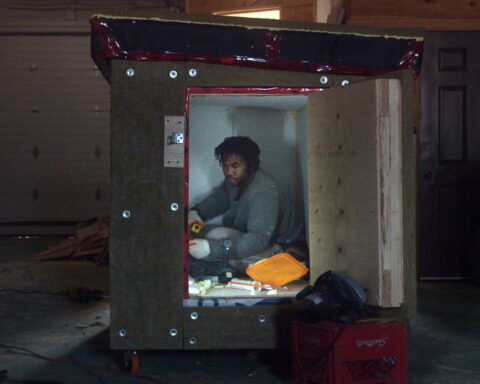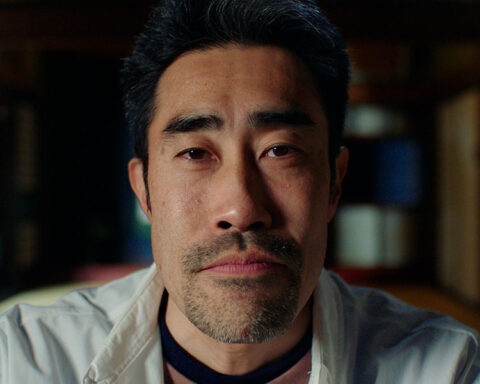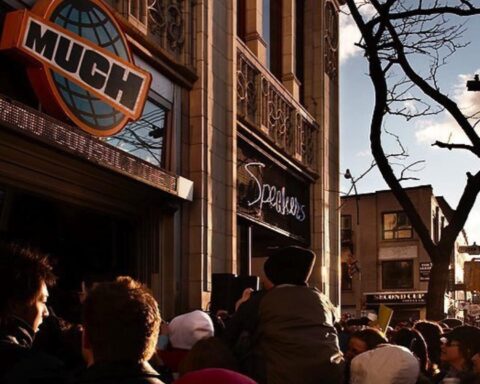The 2013 TIFF documentary lineup retained its high standard, with major filmmakers offering exciting new work. Some of the artists I spent time with were: the experimental team of Godfrey Reggio, Philip Glass (the Qatsi trilogy) and Oscar-winner Stephen Soderbergh, who created Visitors; stalwart observationist Frederick Wiseman and his latest, At Berkeley; and graffiti artist Shepard Fairey and esteemed photographer Chris Jordan, who teamed up with editor Sabine Emiliani (March of the Penguins, the 2005 Oscar winner for best documentary) to make Midway. I would also get to chew the fat with Graeme Mason, head of the New Zealand Film Commission, and see local champions Jody Shapiro (Burt’s Buzz) and Alan Zweig (When Jews Were Funny, the TIFF 2013 winner of Best Canadian Film) in breakfast meetings for guests from the Smithsonian Institute.
Back in the spring, I had seen Sabine Emiliani pitch Midway at the Hot Docs Forum so it was one of my most anticipated films at TIFF.
My thoughts after seeing the trailer and pitch were that this would be a lyrical, stunningly beautiful, poetic and measured piece of moving art, a very important report with disturbing details of how, even on a tiny island, humanity’s garbage is imperiling natural life—in this case, the albatross. By the time the film got to TIFF, the voice-over had become split, alternating between poetic and expositional voices. I’ve since heard that the filmmakers are considering reworking it, and I’m keenly hoping they opt to retain the mysterious version.
Day 1 – Thursday, September 5
As much as I really wanted to be at TIFF for the day-one hoopla, I knew that navigating some outstanding interviews with publicists would pay dividends. While working from the comforts of home felt like a cop-out, it also allowed me to stay on top of things, without the perils of typing while distracted. And I was still able to see films.
At Berkeley is, in my opinion, a masterpiece. As much as I love Wiseman’s previous films, I wasn’t sure if I was going to be up to the full 244 minutes of observational content. To be fair, Wiseman doesn’t appreciate his work being categorized in that way. And that was why it was even more important for me to see the film, given the looming video interview scheduled for the next morning. Remarkably, at 83 years of age, Wiseman is still bringing his A-game and that became very obvious in the opening sequence, where a groundskeeper rides a lawnmower over a picturesquely lush hill, backwards. As much as the shot is a metaphor for the film, which represents a larger story about public education, it’s only the beginning. Watching this film was like diving into a fractal image. It just kept going deeper and deeper. I couldn’t look away. The film is a welling of anti-climax. I’m not sure what other art form could convey such a thing: scene after scene quietly discloses how students, professors and the university’s administration feel about being At Berkeley.
Day 2 – Friday, September 6
A historic day. At the first-ever TIFF First Nations press conference, Alanis Obomsawin (Hi-Ho Mistahey!) spoke of an optimism she is currently encountering across the board in Canadian First Nations communities. Given the prolific career she has had documenting injustice, it made me wonder what she might do next.
Relieved to have made physical contact with the festival, I headed home to watch Jehane Noujaim’s The Square. The film is a great example of how the documentary form can fill voids left by journalism. I read the news frequently, but what I saw in The Square was a total surprise. Through the subjects, a larger story about the convulsions and contradictions of Egypt’s chaos in the wake of dictator Hosni Mubarak’s removal was revealed. This is a story that the Canadian news, for whatever reason, collectively passed over.
Back at TIFF, I had to ask if the filmmakers were aware of the wrongful imprisonment in Cairo of Canadians John Greyson and Dr. Tarek Loubani. Turns out the outspoken lawyer helping the heroes in The Square was also representing our beloved Canadian filmmaker and the humanitarian doctor. This news was conveyed to me by Khalid Abdalla, also an acclaimed actor (The Kite Runner). The Square team, fond of Greyson, was very optimistic that both he and Loubani would be released. Although it would be another whole month before this would happen, they were correct.
Day 3 – Saturday, September 7
The highlight of Saturday was meeting Chuck Workman (What is Cinema?), but this is where I ran into trouble with my run-and-gun coverage. Workman was gracious, but I made a big faux pas off the bat. Grateful for the online screener, I watched it at the last minute without knowing much about Workman or his previous films. All I knew was that he was the guy who used to cut the film excerpts at the Oscars. What is Cinema? is a wonderful documentary departure, touring all kinds of visual alternatives to narrative storytelling. To me, it was fascinating that someone so close to the Oscars would make such a film—which is what prompted my first question: “What on earth would possess you to make a film like this?”, to which he replied, “Well, you do know that I’ve been working in experimental cinema for over 25 years and won an Oscar in 1986 [for Precious Images].” I didn’t. The jig was up. Fortunately, he didn’t end the interview and eventually, I think I made the save due to my knowledge about some of the more obscure films in his montage sequences. On parting I believe we shared a sincerely friendly handshake. This is, after all, a business of relationships.
Day 4 – Sunday, September 8
Sarah McCarthy’s The Dark Matter of Love was on my radar for a couple of reasons. I’d covered her previous film, The Sound of Mumbai: A Musical (2010) and considered her to be a very promising director. McCarthy had given up a day job in development to make Mumbai on a shoestring, so I was also keen to catch up and see how things were going. Dark Matter follows a Wisconsin family headed by ex- Disney employees as they adopt not one but three Russian non-infant orphans. The film is a moving account of how naïve illusions of an idyllic rescue of impoverished East European children clashes with the complexities of realities in the West. It’s a messy petri dish, where the disparity between both sides made this viewer wonder how things could possibly work out well for the subjects. This film caused me to question the point of altruism. While Dark Matter of Love doesn’t directly address issues of policy, it is poignant to note that by the time this film screened at TIFF, the Russian government had stopped allow- ing American adoptions. No Disney ending there.
Next stop was with Graeme Mason (head of the New Zealand Film Commission) and producer Matthew Metcalfe (Beyond the Edge, dir. Leanne Pooley). Having worked in New Zealand a couple times, I was keen to make these connections and to see Metcalfe’s tribute to Sir Edmund Hilary on the 60th anniversary of his Everest conquest. In true Kiwi spirit, the film was made in 3-D and even included footage shot on the rooftop of the world. While I don’t generally enjoy reenact- ments, this film does a very credible job of stitching together previously unreleased archival footage with scenes shot in, you guessed it, New Zealand, standing in for Nepal. It’s doubly poignant due to Hilary’s initial training on Kiwi slopes.
Next peak? Visitors, at the ornate Elgin Theatre. Up there with meeting director Godfrey Reggio’s former cinematographer, Ron Fricke (Baraka, Samsara), my other motion-control time-lapse idol, this event ranked as a most treasured festival moment. As the lights went down I could hear the live score coming not only from the speakers, but also from in front of me, down in the pit, where an orchestra made up of members of the Toronto Symphony was playing Philip Glass’s score. Out of the corner of my eye I could see a faint flicker on the wings of the proscenium from the wave of the conductor’s baton. As a bold infrared shot crept across the face of an abandoned deco monolith, black sky behind it, I slowly felt myself coming down to earth. Tears flowed down my face and I became aware of my purpose in life: I aspire to create this kind of experience for others.
Ironic, then, that Reggio offered up sentiments that echoed Fricke’s. Like many great artists, their intentions are to make something alarm- ingly beautiful, but vague enough that the audience has an opening to place their own meaning onto the images and music. Reflecting on my own reaction, I am glad to have come out of the screening feelingoptimistic, but uncertain that I might ever make a film without a strong opinion. But I’m not sure I completely believe that films like Samsara or Visitors are entirely clear of message either.
On process, I wondered how Glass and Reggio collaborated. Cut the film and then score? Of course, the answer couldn’t be that straight- forward. Glass was actually involved from very early on and attended the shoots. “It’s like cutting your own hair,” says Glass, referring to the back-and-forth of the process. Reggio, the gracious auteur, while prepared to dig into the hard work necessary on such an accom- plishment, also regards the time and space between projects—he’s made four features in 30 years—as equally necessary. His term for it? Productively unemployed.
At the Doc Conference I got to ask the famous artist Shepard Fairey (who created the Obama ‘Hope’ poster and many other graphic designs) what he thinks of Obama now. He was there in support of a new MTV initiative, making docs about musicians in conflict zones. Fairey expressed unequivocal disappointment in his president and went on to say that the artist’s role is not to support politicians but to push them.
Finding Vivian Maier is a gem of a film, told from director John Maloof ’s point of view. While hunting for inexpensive stock images at an auction, Maloof purchased a ream of negatives from the estate of a completely unknown street photographer, Vivian Maier. Recognizing the quality of the images, Maloof first set out to validate their cultural value and ended up pursuing the urge to know who the photographer was. How could it be possible for such a master to have lived without becoming famous in her own lifetime? Having invested significant time and energy into scanning, printing and finding places to exhibit the photography as well as making the film, Maloof is certainly way out on the skinny branches. I sincerely hope that his efforts are rewarded.
Days 7 to 10 – September 11 to 14
For my last interview, Faith Connections director Pan Nalin kept me waiting for some time, but by this point in the festival my pace had been humbled. I didn’t mind at all. It was not only ironic, but well worth it. His film, shot at the famous Hindu pilgrimage Kumbh Mela, is all about being lost and found. In a crowd of 100 million people, Nalin decided to make the film completely on intuition, trusting that if he simply showed up, the story and characters would present themselves. The process of making the film perfectly reflected the nature of the festival in a stunning way. And yes, the characters did show up.
The subtle threads wafting between all the TIFF documentaries left me in awe, not only of the quality of the individual films, but also at their interrelationship. My belief that festival programming is an art form was reinforced. TIFF’s doc programmer, Thom Powers, is certainly a giant in that practice.











